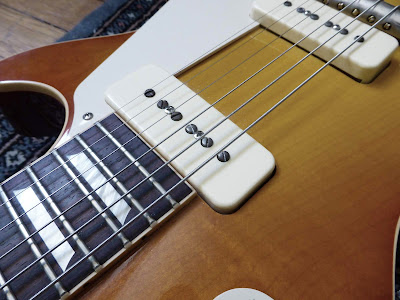
Where it all began: your guitar pickups!
What is electric guitar signal?
As you know, there are 2 types of currents: direct current (DC) and alternate current (AC). Direct current has a fixed value (for example, the +9V that you get from a battery), whereas alternative current oscillate between a positive and a negative value, at a given frequency. For instance, the current oscillate with a 50 Hertz (Hz) frequency on a classic house electrical outlet.

How is volume defined by a voltage?
The signal amplitude (difference between the maximal and minimal voltage value) is directly linked to the volume. The greater the amplitude, the greater the volume! (and vice versa) It is as simple as that.

Historically, amplification could be done only with tubes in the beginning (that you can find in old amplifiers or radios). When transistor was invented, it was then possible to create stompboxes capable of amplifying signal! A common collector circuit is a classic layout that you will find in many circuit, for instance in the big muff circuit. Today, with integrated circuits, it exists smaller op-amps that can amplify the signal with one simple chip! Some of these chips / recent transistors even use almost the same technology as tubes to amplify an audio signal (FET/MOSFET burr brown for example).

100 years of evolution of signal amplification in one picture: a 12AX7 tube, an AC188 germanium transistor, a 2n5089 silicon transistor and a TL072 integrated circuit OP amp
To reduce the signal amplitude (and thus the volume), a simple resistor is enough! That is why there is generally a potentiometer wired as a variable resistor at the end of a circuit to set the output volume. You can find this in many many circuits, like in the Jan Ray.
How alternate current can define a note or pitch?
As we have seen above, alternate current is characterized by a period, which defines a frequency (frequency = 1/period), written in Hertz (Hz). For example, alternate current in an electrical outlet has a frequency of 50 Hz.
Each note has also a frequency! For instance, you may have heard of the 440 A that is the standard pitch used as a reference for many instruments. It is named like this because of its 440 Hertz frequency!
The higher the frequency of oscillation of the current, the higher the pitch is.

Human ear can perceive frequencies between 20 and 20 000 Hz. Practically speaking, it also depends on individuals. With aging, higher frequencies are less and less heard. It is interesting to note that medium frequencies between 1000 and 4000 Hz are perceived louder for a same volume (in decibel). Which is nice for us, guitarists, because electric guitar has a lot of output in these frequencies! And this is how guitarists became famous and not the bassists! (duh!)
Of course, it is a bit more complicated than that. When you play a note, there are many frequencies that are played at the same time, and not only one (harmonics for instance). When you play chords too! When several frequencies are played at the same time, voltages are simply added.
What are effects doing to your signal?
Lets see a few examples of how effects modify your electric guitar signal.1. Compressor
Compressors delimit a maximal amplitude for your signal. By diminishing the amplitude, you "compress" the sound! (all names make sense now, right?)

2. Saturation: overdrives, fuzz, distortions...
Saturation happens when the top and bottom of the signal are clipped. This can be done with different ways: saturation of tubes, transistors, using diodes that will let some voltage go to the ground...etc.

We can also see that the more the signal is saturated, the more it is compressed! This is something you can clearly hear when you use too much saturation for your guitar, or for instance with a big muff.
3. Numeric versus analogue signal
The biggest difference between a numeric and an analogue signal is that an analogue signal can have an infinity of values between 0 and 1, whereas numeric signal is limited because of its binary nature (only 1 and 0...). An analogue signal with an infinite value of 3.3333333...etc. can exist, however a digital signal will stop at some point depending on the quality of it. This quality of the digital signal is generally expressed in bits / kbits per second. A mp3 has a quality between 64 and 256 kbits per second. A CD is 1411 kbits/sec.
So you have a fixed number of points / seconds. The possible values of these points depend on the encoding quality.

The sampling rate also defines the numeric signal quality. The higher it is, the most precise your numeric signal will be (and will not generate noise).
Thus, we can understand why people did not really liked numeric effects at some point. The "coldness" of the sound that you can feel with a numeric pedal comes from this encoding process.
However, today, technology have evolved so much that encoding can be done without an audible quality loss.
For instance, the first digital delay, the Boss DD2, had a 12 bits converter, with a sampling rate of 32kHz (just near radio quality...). Today, Strymon uses 24 bits converter with a 96kHz sampling rate (DVD audio quality!)
Here it is, I hope this article has enlightened you a bit about this mysterious "signal"... If you liked this article, thank me by liking the Coda Effects Facebook page!
Any questions? Post a comment!
To go further:
Analogue versus numeric signal: detailed analysis about differences between analogue and numeric guitar signal by Screaming FX
A bit of theory about compression, clipping...etc.

0 Comment